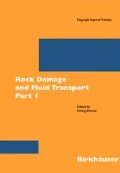Abstract
This paper reviews the use of the cracked Chevron-notched Brazilian disc (CCNBD) for fracture toughness testing. Theoretical and experimental backgrounds of the method are described. Some issues regarding the current development (i.e., recalibration) of the specimen geometry are presented and discussed. A number of geometries related to the CCNBD proposed recently for fracture toughness testing of rock are then introduced and commented on.
Access this chapter
Tax calculation will be finalised at checkout
Purchases are for personal use only
Preview
Unable to display preview. Download preview PDF.
References
Al-Shayea, N.A., Khan, K., and Abduljauwad, S.N. (2000), Effects of confining pressure and temperature on mixed-mode (I-II) fracture toughness of a limestone rock, Int. J. Rock. Mech. and Min. Sci. 37, 629–643.
Chang, S.H., Lee, C.I., and Jeon, S. (2002), Measurement of rock fracture toughness under modes I and II and mixed-mode conditions by using disc-type specimens, Engin. Geology 66, 79–97.
Chen, F., Sun, Z., and Xu, J. (2001), Mode I fracture analysis of the double edge cracked Brazilian disk using a weight function method, Int. J. Rock. Mech. and Min. Sci. 38, 475–479.
Chen, J.F. (1990), The development of chevron-notched Brazilian disk method for rock fracture toughness measurement, Proceeding of 1990 SEM Spring Conf. on Experimental Mechanics, Albuquerque, USA, pp. 18–23.
Chong, K.P., Kuruppu, M.D., and Kuszmaul, J.S. (1987), Fracture toughness determination of rocks with core-based specimens, Proceedings of SEM/RILEM Internat. Conf. on Fracture of Concrete and Rocks, Texas, (Shah S.P. and Swartz, S.E. eds.), pp. 13–25.
Dwivedi, R.D., Soni, A.K., Goell, R.K., and Dube, A.k. (2000), Fracture toughness of rock under subzero temperature conditions, Int. J. Rock. Mech. and Min. Sci. 37, 1267–1275.
Fischer, M.P., Elsworth, D., Alley, R.B., and Engelder, T. (1996), Finite element analysis of the modified ring test for determining mode I fracture toughness, Int. J. Rock. Mech. and Min. Sci. 33, 1–15.
Fowell, R.J. and Xu, C. (1994), The use of the cracked Brazilian disc geometry for rock fracture investigation, Int. J. Rock. Mech. and Min. Sci. 31, 571–579.
Funatsu, T., Seto, M., Shimada, H., Matsui, K., and Kuruppu, M. (2004), Combined effects of increasing temperature and confining pressure on the fracture toughness of clay bearing rocks, Int. J. Rock. Mech. and Min. Sci., 41, 927–938.
Guo, H., Aziz, N.I., and Schmidt, L.C. (1993), Rock fracture toughness determination by Brazilian test, Engin. Geology 33, 177–188.
Krishnan, G.R., Zhao, X.L., Zaman, M., and Roegiers, J.C. (1998), Fracture toughness of a soft sandstone, Int. J. Rock. Mech. and Min. Sci. 35, 695–710.
Isrm Commission on Testing Methods (1995), Suggested method for determining Mode I fracture toughness using cracked Chevron-notched Brazilian disc (CCNBD) specimens, R.J. FOWELL (coordinator), Int. J. Rock. Mech. and Min. Sci. 32, 57–64.
Lim, I.L., Johnston, I.W., Choi, S.K., and Boland, J.N. (1994a), Fracture testing of a soft rock with semicircular specimens under three-point bending part 1-mode I, Int. J. Rock. Mech. and Min. Sci. 31, 185–197.
Lim, I.L., Johnston, I.W., Choi, S.K., and Boland, J.N. (1994b), Fracture testing of a oft rock with semicircular specimens under three-point bending part 2-mixed modes, Int. J. Rock. Mech. and Min. Sci., 31, 199–212.
Lim, I.L., Johnston, I.W., and Choi, S.K. (1994c), Assessment of mixed-mode fracture toughness testing methods for rock, Int. J. Rock. Mech. and Min. Sci. 31, 265–272.
Xu, C. and Fowell, R.J. (1994), The crack chevron-notched Brazilian dist test-geometrical considerations for practical rock fracture toughness measurement, Int. J. Rock. Mech. and Min. Sci. 30, 821–824.
Xu, C. and Fowell, R.J. (1993), Experimental validation of the cracked chevron-notched Brazilian disc geometry specimen for rock fracture toughness testing, LUMA Magazine, Leeds University Mining Association, pp. 57–68.
Wang, Q.Z. (1998), Stress intensity factors of the ISRM suggested CCNBD specimen used for mode I fracture toughness determination, Int. J. Rock. Mech. and Min. Sci. 35, 977–982.
Wang, Q.Z., Jia, X.M., and Wu, L.Z. (2004), Wide range stress intensity factors for the ISRM suggested method using CCNBD specimens for the rock fracture toughness tests, Int. J. Rock. Mech. and Min. Sci. 41, 709–716.
Wang, Q.Z., Jia, X.M., Kou, S.Q., Zhang, Z.X., and Lindqvist, P.-A. (2004), The flattened Brazilian disc specimen used for elastic modulus, tensile strength and fracture toughness of brittle rocks: analytical and numerical results, Int. J. Rock. Mech. and Min. Sci. 41, 245–253.
Author information
Authors and Affiliations
Editor information
Editors and Affiliations
Rights and permissions
Copyright information
© 2006 Birkhäuser Verlag, Basel
About this chapter
Cite this chapter
Fowell, R.J., Xu, C., Dowd, P.A. (2006). An Update on the Fracture Toughness Testing Methods Related to the Cracked Chevron-notched Brazilian Disk (CCNBD) Specimen. In: Dresen, G., Zang, A., Stephansson, O. (eds) Rock Damage and Fluid Transport, Part I. Pageoph Topical Volumes. Birkhäuser Basel. https://doi.org/10.1007/3-7643-7712-7_8
Download citation
DOI: https://doi.org/10.1007/3-7643-7712-7_8
Received:
Revised:
Accepted:
Published:
Publisher Name: Birkhäuser Basel
Print ISBN: 978-3-7643-7711-3
Online ISBN: 978-3-7643-7712-0
eBook Packages: Earth and Environmental ScienceEarth and Environmental Science (R0)

